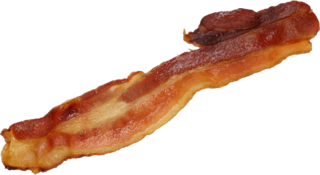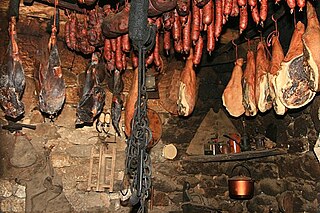Macon is a cured and smoked form of mutton. [1] Macon is prepared in a similar manner to bacon, with the meat being either dry cured with large quantities of salt or wet cured with brine and then smoked. The name macon is a portmanteau word of mutton and bacon. In South Africa the term is also used for other bacon substitutes, including ones made from beef. [2]
Generally macon has a light black and yellow color, with the outer edges being a darker pink. Macon looks and feels similar to bacon. It would more commonly be found in a thin sliced form used in sandwiches, or as a smaller cut slice topping on a pizza.[ citation needed ]
It is also used as a bacon substitute for religious groups such as Jews and Muslims, whose faith does not allow the consumption of pork.
Local macon production has been practiced for centuries in Scotland. It was mass-produced in the United Kingdom during World War II when rationing was instituted. Scottish lawyer and politician Frederick Alexander Macquisten, was the first to suggest mass production of macon. "If the Parliamentary Secretary to the Minister of Food will consult with any farmer's wife in Perthshire, she will show him how to cure it," he informed the House of Commons. This led to its popular name Macon's bacon. [3]

Ham is pork from a leg cut that has been preserved by wet or dry curing, with or without smoking. As a processed meat, the term ham includes both whole cuts of meat and ones that have been mechanically formed.

Bacon is a type of salt-cured pork made from various cuts, typically the belly or less fatty parts of the back. It is eaten as a side dish, used as a central ingredient, or as a flavouring or accent. Regular bacon consumption is associated with increased mortality and other health concerns.

Corned beef, bully beef, or salt beef in some Commonwealth countries, is a salt-cured brisket of beef. The term comes from the treatment of the meat with large-grained rock salt, also called "corns" of salt. Sometimes, sugar and spices are added to corned beef recipes. Corned beef is featured as an ingredient in many cuisines.

A sausage is a type of meat product usually made from ground meat—often pork, beef, or poultry—along with salt, spices and other flavourings. Other ingredients, such as grains or breadcrumbs, may be included as fillers or extenders.

Braunschweiger is a type of sausage. The type of sausage the term refers to varies by region. In the German language, Braunschweiger is the demonym for people from Brunswick, but under German food law refers to a variety of mettwurst. In Austria, Braunschweiger is known as a type of parboiled sausage (Brühwurst), while American Braunschweiger is often confused with liverwurst.

Goulash is a soup or stew of meat and vegetables seasoned with paprika and other spices. Originating in Hungary, goulash is a common meal predominantly eaten in Central Europe but also in other parts of Europe. It is one of the national dishes of Hungary and a symbol of the country.

Eggs Benedict is a common American breakfast or brunch dish, consisting of two halves of an English muffin, each topped with Canadian bacon or sliced ham, a poached egg, and hollandaise sauce. The dish is believed to have originated in New York City.

Smoked meat is the result of a method of preparing red meat, white meat, and seafood which originated in the Paleolithic Era. Smoking adds flavor, improves the appearance of meat through the Maillard reaction, and when combined with curing it preserves the meat. When meat is cured then cold-smoked, the smoke adds phenols and other chemicals that have an antimicrobial effect on the meat. Hot smoking has less impact on preservation and is primarily used for taste and to slow-cook the meat. Interest in barbecue and smoking is on the rise worldwide.

Pancetta is a salt-cured pork belly meat product in a category known as salume. In Italy, it is often used to add depth to soups and pasta.
Serbian cuisine is a Balkan cuisine that consists of the culinary methods and traditions of Serbia. Its roots lie in Serbian history, including centuries of cultural contact and influence with the Greeks and the Byzantine Empire, the Ottomans, and Serbia's Balkan neighbours, especially during the existence of Yugoslavia. Historically, Serbian food develops from pastoral customs that involved the keeping of sheep in mountain highlands, in a climate and regional context that favoured animal husbandry over vegetable farming; Serbian food is therefore traditionally richer in animal products and basic grains—corn, wheat and oats—than fresh vegetable dishes. Following the abandonment of widely practiced pastoral lifestyles, Serbian food emerged through the Middle Ages heavily dependent not on lamb or mutton, but on the keeping of pigs for the annual cull and the production of various cured meats, such as sausages, bacon and ham products.
Norwegian cuisine in its traditional form is based largely on the raw materials readily available in Norway. It differs in many respects from continental cuisine with a stronger focus on game and fish. Many of the traditional dishes are the result of using conserved materials because of the long winters.

The origins of meat preservation are lost to the ages but probably began when humans began to realize the preservative value of salt. Sausage making originally developed as a means to preserve and transport meat. Primitive societies learned that dried berries and spices could be added to dried meat. The procedure of stuffing meat into casings remains basically the same today, but sausage recipes have been greatly refined and sausage making has become a highly respected culinary art.

Scottish cuisine encompasses the cooking styles, traditions and recipes associated with Scotland. It has distinctive attributes and recipes of its own, but also shares much with other British and wider European cuisine as a result of local, regional, and continental influences — both ancient and modern.

Cured fish is fish which has been cured by subjecting it to fermentation, pickling, smoking, or some combination of these before it is eaten. These food preservation processes can include adding salt, nitrates, nitrite or sugar, can involve smoking and flavoring the fish, and may include cooking it. The earliest form of curing fish was dehydration. Other methods, such as smoking fish or salt-curing also go back for thousands of years. The term "cure" is derived from the Latin curare, meaning to take care of. It was first recorded in reference to fish in 1743.

Hangikjöt is a traditional festive food in Iceland, served at Christmas.

Bacon and cabbage is a dish traditionally associated with Ireland. The dish consists of sliced back bacon boiled with cabbage and potatoes. Smoked bacon is sometimes used. The dish is served with the bacon sliced, and with some of the boiling juices added. Another common accompaniment to the dish is white sauce, which consists of flour, butter and milk, sometimes with a flavouring of some sort.

Turkey bacon is a meat prepared from chopped, formed, cured, and smoked turkey, commonly marketed as a low-fat alternative to pork bacon; it may also be used as a substitute for bacon where religious dietary laws forbid the consumption of pork products.

Peameal bacon is a wet-cured, unsmoked back bacon made from trimmed lean boneless pork loin rolled in cornmeal. It is found mainly in Ontario. Toronto pork packer William Davies, who moved to Canada from England in 1854, is credited with its development.